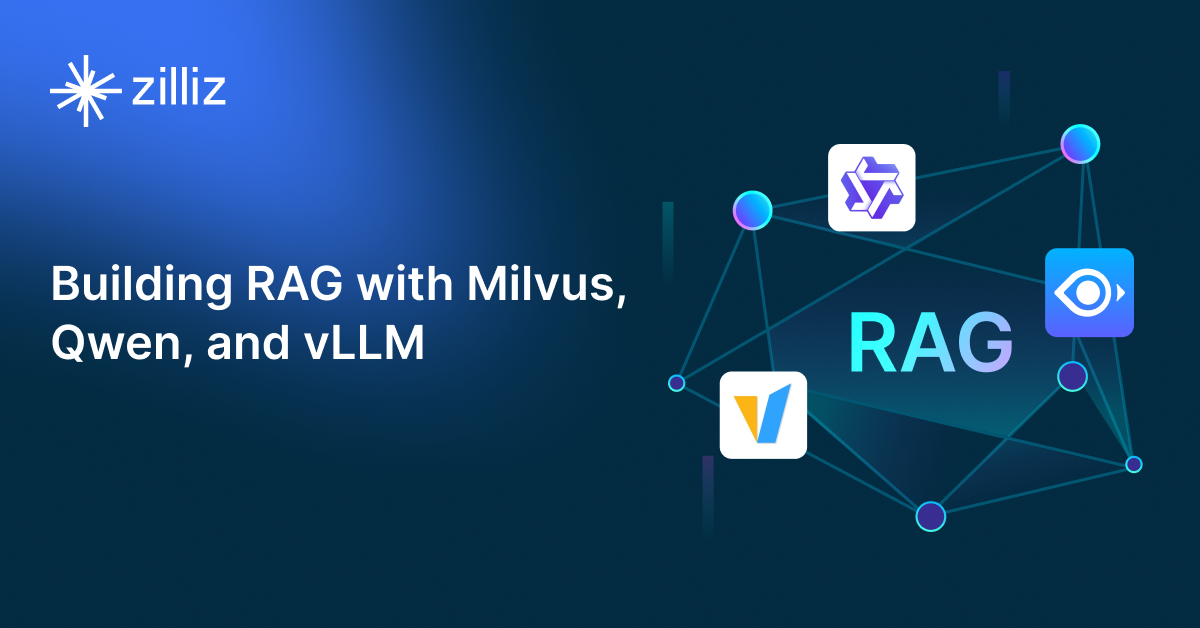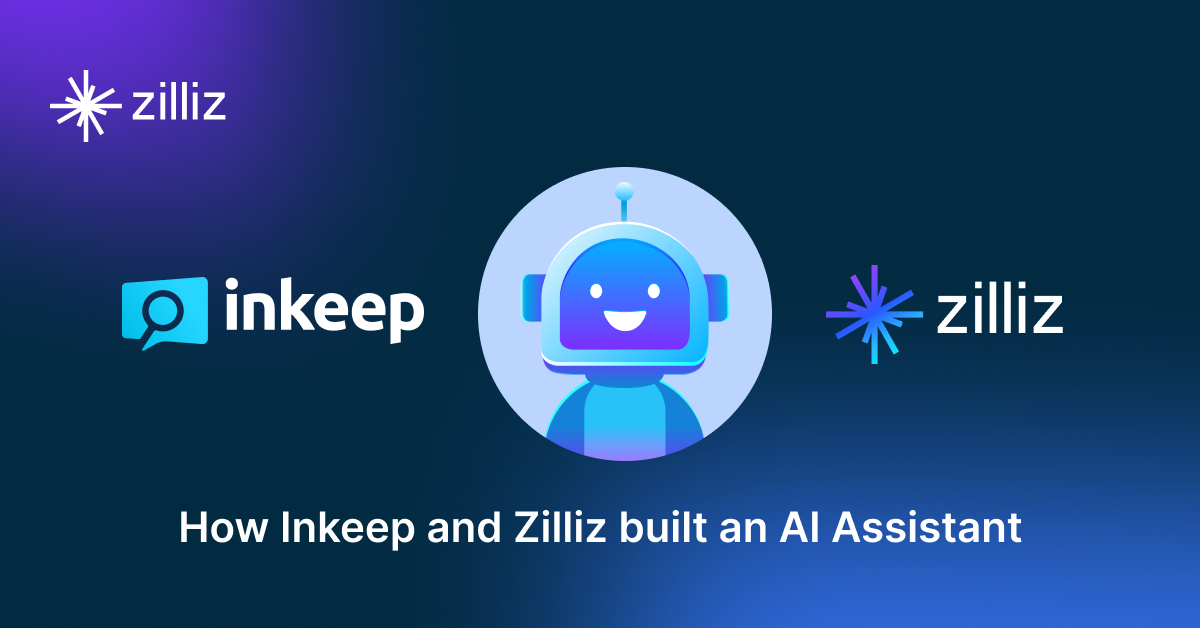Build RAG Chatbot with Llamaindex, HNSWlib, Mistral 7B, and Cohere embed-multilingual-v2.0
Introduction to RAG
Retrieval-Augmented Generation (RAG) is a game-changer for GenAI applications, especially in conversational AI. It combines the power of pre-trained large language models (LLMs) like OpenAI’s GPT with external knowledge sources stored in vector databases such as Milvus and Zilliz Cloud, allowing for more accurate, contextually relevant, and up-to-date response generation. A RAG pipeline usually consists of four basic components: a vector database, an embedding model, an LLM, and a framework.
Key Components We'll Use for This RAG Chatbot
This tutorial shows you how to build a simple RAG chatbot in Python using the following components:
- Llamaindex: a data framework that connects large language models (LLMs) with various data sources, enabling efficient retrieval-augmented generation (RAG). It helps structure, index, and query private or external data, optimizing LLM applications for search, chatbots, and analytics.
- HNSWlib: a high-performance C++ and Python library for approximate nearest neighbor (ANN) search using the Hierarchical Navigable Small World (HNSW) algorithm. It provides fast, scalable, and efficient similarity search in high-dimensional spaces, making it ideal for vector databases and AI applications.
- Mistral 7B: A 7-billion parameter open-source language model optimized for efficiency and versatility in natural language processing. It excels in text generation, summarization, and question answering, balancing performance with lower computational demands. Ideal for chatbots, content creation, code generation, and real-time applications where resource efficiency and rapid deployment are critical.
- Cohere embed-multilingual-v2.0: A multilingual embedding model designed to convert text in over 100 languages into high-dimensional vectors. It excels in capturing semantic relationships across diverse languages, enabling robust cross-lingual search, content recommendation, and multilingual NLP applications. Ideal for global enterprises needing scalable, language-agnostic text analysis and retrieval solutions.
By the end of this tutorial, you’ll have a functional chatbot capable of answering questions based on a custom knowledge base.
Note: Since we may use proprietary models in our tutorials, make sure you have the required API key beforehand.
Step 1: Install and Set Up Llamaindex
pip install llama-index
Step 2: Install and Set Up Mistral 7B
%pip install llama-index-llms-mistralai
from llama_index.llms.mistralai import MistralAI
llm = MistralAI(model="open-mistral-7b")
Step 3: Install and Set Up Cohere embed-multilingual-v2.0
%pip install llama-index-embeddings-cohere
from llama_index.embeddings.cohere import CohereEmbedding
embed_model = CohereEmbedding(
api_key=cohere_api_key,
model_name="embed-multilingual-v2.0",
)
Step 4: Install and Set Up HNSWlib
%pip install llama-index-vector-stores-hnswlib
from llama_index.vector_stores.hnswlib import HnswlibVectorStore
from llama_index.core import (
VectorStoreIndex,
StorageContext,
SimpleDirectoryReader,
)
vector_store = HnswlibVectorStore.from_params(
space="ip",
dimension=embed_model._model.get_sentence_embedding_dimension(),
max_elements=1000,
)
Step 5: Build a RAG Chatbot
Now that you’ve set up all components, let’s start to build a simple chatbot. We’ll use the Milvus introduction doc as a private knowledge base. You can replace it with your own dataset to customize your RAG chatbot.
import requests
from llama_index.core import SimpleDirectoryReader
# load documents
url = 'https://raw.githubusercontent.com/milvus-io/milvus-docs/refs/heads/v2.5.x/site/en/about/overview.md'
example_file = 'example_file.md' # You can replace it with your own file paths.
response = requests.get(url)
with open(example_file, 'wb') as f:
f.write(response.content)
documents = SimpleDirectoryReader(
input_files=[example_file]
).load_data()
print("Document ID:", documents[0].doc_id)
storage_context = StorageContext.from_defaults(vector_store=vector_store)
index = VectorStoreIndex.from_documents(
documents, storage_context=storage_context, embed_model=embed_model
)
query_engine = index.as_query_engine(llm=llm)
res = query_engine.query("What is Milvus?") # You can replace it with your own question.
print(res)
Example output
Milvus is a high-performance, highly scalable vector database designed to operate efficiently across various environments, from personal laptops to large-scale distributed systems. It is available as both open-source software and a cloud service. Milvus excels in managing unstructured data by converting it into numerical vectors through embeddings, which facilitates fast and scalable searches and analytics. The database supports a wide range of data types and offers robust data modeling capabilities, allowing users to organize their data effectively. Additionally, Milvus provides multiple deployment options, including a lightweight version for quick prototyping and a distributed version for handling massive data scales.
Optimization Tips
As you build your RAG system, optimization is key to ensuring peak performance and efficiency. While setting up the components is an essential first step, fine-tuning each one will help you create a solution that works even better and scales seamlessly. In this section, we’ll share some practical tips for optimizing all these components, giving you the edge to build smarter, faster, and more responsive RAG applications.
LlamaIndex optimization tips
To optimize LlamaIndex for a Retrieval-Augmented Generation (RAG) setup, structure your data efficiently using hierarchical indices like tree-based or keyword-table indices for faster retrieval. Use embeddings that align with your use case to improve search relevance. Fine-tune chunk sizes to balance context length and retrieval precision. Enable caching for frequently accessed queries to enhance performance. Optimize metadata filtering to reduce unnecessary search space and improve speed. If using vector databases, ensure indexing strategies align with your query patterns. Implement async processing to handle large-scale document ingestion efficiently. Regularly monitor query performance and adjust indexing parameters as needed for optimal results.
HNSWlib optimization tips
To optimize HNSWlib for a Retrieval-Augmented Generation (RAG) setup, fine-tune the M parameter (number of connections per node) to balance accuracy and memory usage—higher values improve recall but increase indexing time. Adjust ef_construction (search depth during indexing) to enhance retrieval quality. During queries, set ef_search dynamically based on latency vs. accuracy trade-offs. Use multi-threading for faster indexing and querying. Ensure vectors are properly normalized for consistent similarity comparisons. If working with large datasets, periodically rebuild the index to maintain efficiency. Store the index on disk and load it efficiently for persistence in production environments. Monitor query performance and tweak parameters to achieve optimal speed-recall balance.
Mistral 7B optimization tips
To enhance Mistral 7B's performance in RAG, prioritize prompt engineering with concise, structured instructions and few-shot examples to guide outputs. Use smaller text chunks (256-512 tokens) for retrieval to reduce noise and improve relevance. Fine-tune Mistral 7B on domain-specific data using LoRA for efficient adaptation. Enable 4-bit quantization via Hugging Face’s bitsandbytes to reduce memory usage without significant accuracy loss. Adjust temperature (0.1-0.3) and top-p (0.9-0.95) for balanced creativity and precision. Cache frequent queries and precompute embeddings to accelerate inference.
Cohere embed-multilingual-v2.0 optimization tips
To optimize Cohere embed-multilingual-v2.0 in RAG, preprocess text by normalizing languages (lowercasing, removing diacritics) and chunking documents into 512-token segments for compatibility. Use domain-specific fine-tuning via Cohere’s API to align embeddings with specialized vocabularies. Cache frequently accessed embeddings to reduce latency and costs. Batch embedding requests for bulk processing. Align query language with document language for improved retrieval accuracy, and apply L2 normalization before similarity calculations. Monitor retrieval hit rates to refine chunking strategies and fine-tuning datasets iteratively.
By implementing these tips across your components, you'll be able to enhance the performance and functionality of your RAG system, ensuring it’s optimized for both speed and accuracy. Keep testing, iterating, and refining your setup to stay ahead in the ever-evolving world of AI development.
RAG Cost Calculator: A Free Tool to Calculate Your Cost in Seconds
Estimating the cost of a Retrieval-Augmented Generation (RAG) pipeline involves analyzing expenses across vector storage, compute resources, and API usage. Key cost drivers include vector database queries, embedding generation, and LLM inference.
RAG Cost Calculator is a free tool that quickly estimates the cost of building a RAG pipeline, including chunking, embedding, vector storage/search, and LLM generation. It also helps you identify cost-saving opportunities and achieve up to 10x cost reduction on vector databases with the serverless option.
 Calculate your RAG cost
Calculate your RAG cost
What Have You Learned?
Congratulations on making it through this tutorial! You've just unlocked the doors to an exciting new world of information retrieval and knowledge enhancement by learning how to build a Retrieval-Augmented Generation (RAG) system with a well-crafted framework, a powerful vector database, a versatile language model, and an efficient embedding model. You explored how LlamaIndex seamlessly organizes data, allowing you to build a robust pipeline for efficiently retrieving relevant information. Then, with the wizardry of HNSWlib, you discovered how to index and search large data sets in record time, making your information retrieval both fast and precise. You’ve also dived into the capabilities of Mistral 7B, leveraging its generative prowess to create insightful, coherent text that builds upon the retrieved context. Don’t forget about the power of the Cohere embed-multilingual-v2.0 model, which broke down language barriers and expanded the horizons of your application.
But that’s not all—you’ve also gained invaluable insights on optimizing your RAG deployment and even discovered a handy free RAG cost calculator to help you budget your project. This tutorial didn't just teach you the technical aspects; it also engaged your creative side, inspiring you to think innovatively about how to apply these tools in real-world scenarios. Now, it’s your turn to take this knowledge and run with it! Start building, optimizing, and innovating your RAG applications—there’s a whole world of possibilities waiting for you. Go ahead and unleash your creativity; the journey of transforming information into meaningful insights has only just begun!
Further Resources
🌟 In addition to this RAG tutorial, unleash your full potential with these incredible resources to level up your RAG skills.
- How to Build a Multimodal RAG | Documentation
- How to Enhance the Performance of Your RAG Pipeline
- Graph RAG with Milvus | Documentation
- How to Evaluate RAG Applications - Zilliz Learn
- Generative AI Resource Hub | Zilliz
We'd Love to Hear What You Think!
We’d love to hear your thoughts! 🌟 Leave your questions or comments below or join our vibrant Milvus Discord community to share your experiences, ask questions, or connect with thousands of AI enthusiasts. Your journey matters to us!
If you like this tutorial, show your support by giving our Milvus GitHub repo a star ⭐—it means the world to us and inspires us to keep creating! 💖
- Introduction to RAG
- Key Components We'll Use for This RAG Chatbot
- Step 1: Install and Set Up Llamaindex
- Step 2: Install and Set Up Mistral 7B
- Step 3: Install and Set Up Cohere embed-multilingual-v2.0
- Step 4: Install and Set Up HNSWlib
- Step 5: Build a RAG Chatbot
- Optimization Tips
- RAG Cost Calculator: A Free Tool to Calculate Your Cost in Seconds
- What Have You Learned?
- Further Resources
- We'd Love to Hear What You Think!
Content
Vector Database at Scale
Zilliz Cloud is a fully-managed vector database built for scale, perfect for your RAG apps.
Try Zilliz Cloud for Free


